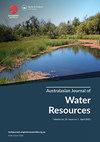Bioretention performance: a review of field studies
IF 2.2
Q2 WATER RESOURCES
引用次数: 2
Abstract
ABSTRACT Over the past decade, there have been multiple studies into how bioretention systems perform in field, rather than laboratory, conditions, and into the quality of stormwater coming off urban catchments, yet in Australia standards, guidelines and software models have remained relatively static. A review of 15 field studies of bioretention systems, collectively covering 513 storm events, found a weighted average volumetric loss of 51% despite many of the systems having impermeable liners or were on clayey soils. The loss of water is about 17 times higher than is predicted by MUSIC when configured in accordance with standard guidelines. Some of the studies found increased pollutant concentrations in the effluent, with volumetric loss being the primary mechanism for pollutant load reduction. This research shows that bioretention systems perform more like sponges than filters and can have a potentially large impact on urban hydrology by reducing the volume and frequency of runoff, and helping attenuate minor flood events. Ultimately, this could lead to a better integration of the quality and quantity aspects of urban stormwater management.生物记忆性能:实地研究综述
在过去的十年中,人们对生物滞留系统在野外(而非实验室)条件下的表现以及城市集水区雨水的质量进行了多次研究,但在澳大利亚,标准、指南和软件模型仍然相对静止。对涵盖513次风暴事件的15项生物滞留系统的实地研究进行了回顾,发现尽管许多系统有不透水的衬垫或在粘土上,但加权平均体积损失为51%。如果按照标准准则进行配置,失水量大约是MUSIC预测的17倍。有些研究发现,污水中的污染物浓度增加,而体积损失是减少污染物负荷的主要机制。这项研究表明,生物滞留系统的作用更像海绵而不是过滤器,可以通过减少径流的数量和频率,并帮助减轻小型洪水事件,对城市水文产生潜在的巨大影响。最终,这可能导致更好地整合城市雨水管理的质量和数量方面。
本文章由计算机程序翻译,如有差异,请以英文原文为准。
求助全文
约1分钟内获得全文
求助全文
来源期刊

Australasian Journal of Water Resources
WATER RESOURCES-
CiteScore
5.10
自引率
21.90%
发文量
25
期刊介绍:
The Australasian Journal of Water Resources ( AJWR) is a multi-disciplinary regional journal dedicated to scholarship, professional practice and discussion on water resources planning, management and policy. Its primary geographic focus is on Australia, New Zealand and the Pacific Islands. Papers from outside this region will also be welcomed if they contribute to an understanding of water resources issues in the region. Such contributions could be due to innovations applicable to the Australasian water community, or where clear linkages between studies in other parts of the world are linked to important issues or water planning, management, development and policy challenges in Australasia. These could include papers on global issues where Australasian impacts are clearly identified.
 求助内容:
求助内容: 应助结果提醒方式:
应助结果提醒方式:


